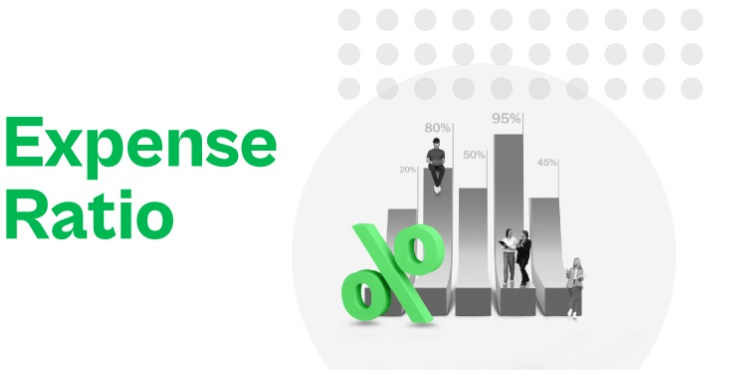Expense Ratio in Mutual Funds Key Insights for Informed Investors

The world of mutual funds has evolved considerably over the years, becoming one of the most popular investment options. Yet, while many focus on returns and fund performance, they often overlook another critical aspect of mutual fund investing—the expense ratio. For informed investors, understanding the concept of the expense ratio in mutual funds is key to making sound investment decisions that align with financial goals.
What Is the Expense Ratio in Mutual Funds?
The expense ratio in mutual fund represents the annual fee a fund house charges to manage a specific mutual fund. This fee is expressed as a percentage of the fund’s average assets under management (AUM). In simpler terms, it is the cost investors incur for professional fund management, administrative expenses, operational charges, and distribution expenses.
For example, if a mutual fund has an average AUM of ₹1 crore and an expense ratio of 1.20%, then the expense paid by the investors would be ₹1,20,000 per year.
Components of an Expense Ratio
The expense ratio consists of multiple components that cover all aspects of the fund’s operation. These typically include:
1. Management Fees: Fees paid to fund managers for making investment decisions and portfolio management.
2. Administrative Expenses: Costs related to maintaining day-to-day operations, such as record-keeping and compliance with regulations.
3. Marketing and Distribution Expenses: Charges for promotional activities and commissions for financial intermediaries who sell the mutual fund.
By dissecting these components, investors can gain a clearer picture of what they are paying for.
What Is the Total Expense Ratio?
The Total Expense Ratio (TER) is the cumulative measure of all costs associated with managing the fund. It includes management fees, operational costs, and other direct or indirect expenses.
The TER for a fund is calculated using the formula:
TER (%) = (Total Expenses / Average AUM) × 100
Example Calculation:
Suppose a mutual fund had an average AUM of ₹2 crore over the financial year and incurred total expenses amounting to ₹3,00,000. The TER can be calculated as:
TER (%) = (₹3,00,000 / ₹2,00,00,000) × 100
TER (%) = 1.5%
This means investors in this mutual fund would effectively bear a cost of 1.5% annually on their contributions to the fund.
Why Is the Expense Ratio Crucial?
Understanding the expense ratio is essential as it directly impacts the net returns investors receive. Mutual fund returns are calculated after deducting the expense ratio, making it a significant factor to consider before investing.
Here’s an example comparing two funds with different expense ratios:
1. Fund A has an annual return of 12% and an expense ratio of 1.00%.
2. Fund B has an annual return of 12% and an expense ratio of 2.00%.
The net returns for each fund will be:
– Fund A: 12% – 1% = 11% net returns
– Fund B: 12% – 2% = 10% net returns
Clearly, Fund A provides a higher return purely because of its lower expense ratio, which eats into less of the investor’s profits.
Types of Mutual Funds by Expense Ratio Range
Expense ratios vary widely depending on the type of mutual fund:
1. Index Funds and ETFs: These passive funds generally have the lowest expense ratios, typically ranging from 0.1% to 0.50%, as they simply track a benchmark index without needing extensive management.
2. Debt Funds: Debt funds, which invest in fixed-income instruments, tend to have moderately low expense ratios compared to equity-based funds.
3. Equity Funds: Actively managed equity funds often have higher expense ratios, ranging from 1% to 2%, owing to the intensive research and analysis involved in stock selection.
4. Hybrid Funds: Since these funds combine equity and debt instruments, their expense ratios usually fall in the mid-range.
Factors Affecting the Expense Ratio
Several factors influence expense ratios:
1. Fund Size: Larger funds typically have lower expense ratios because operational costs are distributed across a larger base of assets.
2. Investment Strategy: Actively managed funds usually incur higher expenses compared to passive funds like index funds.
3. Regulatory Limits: In India, the Securities and Exchange Board of India (SEBI) has prescribed upper limits for TER based on the fund’s AUM size. For example:
– For AUM up to ₹500 crores, the maximum TER is 2.25%.
– For AUM over ₹50,000 crores, the maximum TER drops to 1.05%.
How Does the Expense Ratio Impact Long-Term Returns?
For long-term investors, even small differences in the expense ratio can lead to significant divergences in portfolio value over time. Here’s a scenario illustrating the importance:
Consider two funds with an initial investment of ₹5,00,000:
1. Fund C: Expense ratio of 0.75%
2. Fund D: Expense ratio of 1.50%
If both funds generate an annual return of 10% over 20 years, their ending values would be:
– Fund C:
Final Value = ₹5,00,000 × (1 + 10% – 0.75%)^20
Final Value = ₹5,00,000 × (1 + 9.25%)^20 = ₹27,31,994
– Fund D:
Final Value = ₹5,00,000 × (1 + 10% – 1.50%)^20
Final Value = ₹5,00,000 × (1 + 8.50%)^20 = ₹25,84,369
Difference: Fund C, with a lower expense ratio, grows ₹1,47,625 more than Fund D over 20 years—highlighting the long-term impact of expense ratios.
Summary:
The expense ratio in mutual funds is a percentage-based charge by fund houses to cover operational, administrative, and management costs. It significantly influences investor returns by deducting yearly fees from the fund’s performance. When evaluating mutual funds, the Total Expense Ratio (TER) offers a complete picture of a fund’s expenses compared to its average assets under management (AUM).
In India, SEBI regulates the TER to ensure fairness across funds of varying sizes. While passive funds like index and debt funds usually have a lower expense ratio, actively managed funds like equity funds often incur higher costs. Over time, seemingly small differences in expense ratios can lead to substantial disparities in portfolio values, especially for long-term investors.
Investors should be diligent when reviewing the expense ratio of mutual funds alongside performance metrics while aligning investments with their financial goals.
Disclaimer:
Investors are advised to thoroughly evaluate all pros and cons of trading in the Indian financial market. This article serves for informational purposes only and does not constitute financial advice. Past performance and expense ratios are not guaranteed indicators of future outcomes. Always consult with a professional advisor before making investment decisions.







